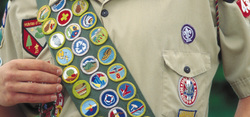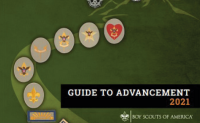 January first is usually a significant day in the advancement process. Most rank and merit badge requirement changes become effective as of the first of the year. New Year’s Day in 2016 marked significant and sweeping changes in Boy Scout requirements. Most ranks saw changes or an overhaul, and Scout was added as an official rank and not just the joining requirement. The permissive period started January 1, 2016, meaning that Scouts who were working toward a rank could continue to use the old requirements until they completed that rank, but had to use the new requirements if they started after that date. As of January 1, 2017, all Scouts have to use the new requirements.
January first is usually a significant day in the advancement process. Most rank and merit badge requirement changes become effective as of the first of the year. New Year’s Day in 2016 marked significant and sweeping changes in Boy Scout requirements. Most ranks saw changes or an overhaul, and Scout was added as an official rank and not just the joining requirement. The permissive period started January 1, 2016, meaning that Scouts who were working toward a rank could continue to use the old requirements until they completed that rank, but had to use the new requirements if they started after that date. As of January 1, 2017, all Scouts have to use the new requirements.
Possibly less noticed were the requirement changes that took effect January 1, 2017. Yes, there were a few – some you probably didn’t hear about – but they are worth noting. Thankfully, just two rank requirements – Second Class and First Class – underwent only changes of an editorial nature involving rephrasing a couple items.
The bigger changes took place in the merit badge program.
- A new merit badge – Exploration – became available January 1. This badge was only announced with little fanfare in late 2016, and in fact the official press release just came out a couple weeks ago, so it’s understandable if you didn’t notice its appearance. Requirements for Exploration include examining the role of exploration in history, how it is employed in various industries and pursuits such as aerospace and natural resources, and learning about an explorer or exploration mission. Then, plan, prepare for, and carry out an expedition. It’s a rather involved merit badge which may appeal to the more adventurous Scouts.
- Major changes were made to four merit badges: Disabilities Awareness, Hiking, Pioneering and Radio. Many of the changes involved rewording or reordering existing requirements. In some cases, new requirements were added, as well as new options. For example, Disabilities Awareness now allows Scouts to examine the impact of “invisible” disabilities as an option, and for Radio, the practicum requirement adds direction finding as an alternative to amateur, broadcast and shortwave listening.
- Minor revisions were made to thirty-two other merit badges. Most of these changes involve editorial revisions – rearranging or changing words, or adding more descriptive imperatives. Some outdated requirements were deleted or replaced with more contemporary ones. For example, the Music merit badge previously required a Scout to catalog his family’s CD collection, but with physical media being overtaken by streaming and downloads, that requirement was replaced with one about intellectual property and file sharing.
The official requirements for ranks and merit badges can be found at the BSA’s website, and a printed version, the Boy Scout Requirements booklet, should be out in the spring. A thorough detailing of the changes – what’s been added, dropped and changed – is provided by the US Scouting Service Project.
Image: Scouting Magazine
This post first appeared on Bobwhite Blather.



